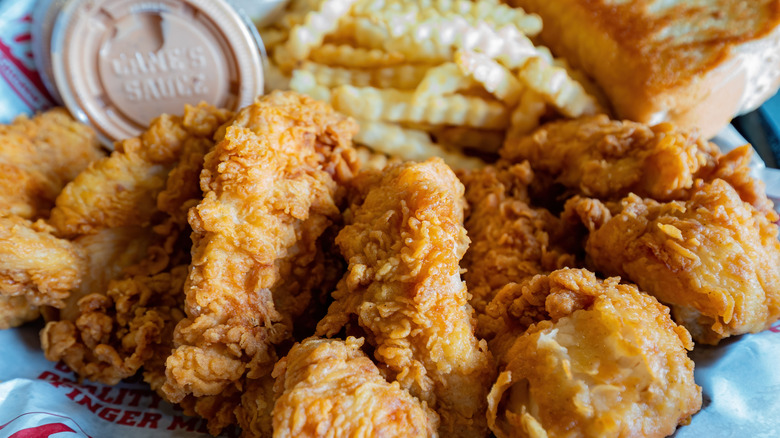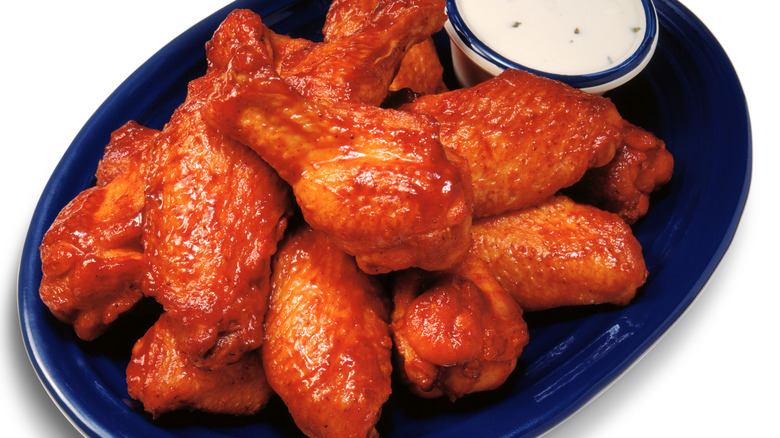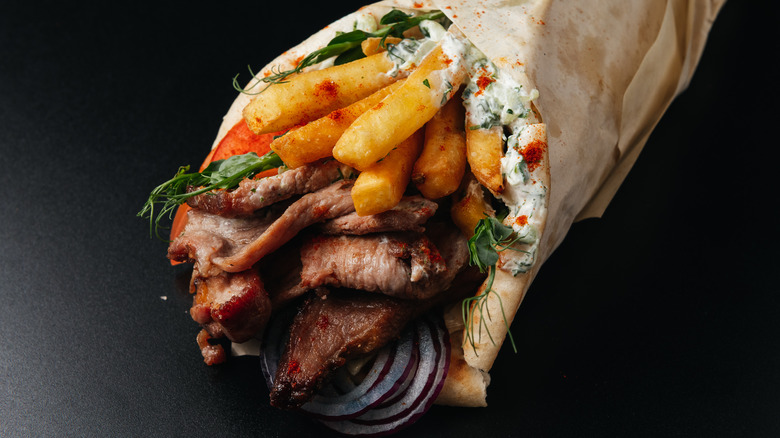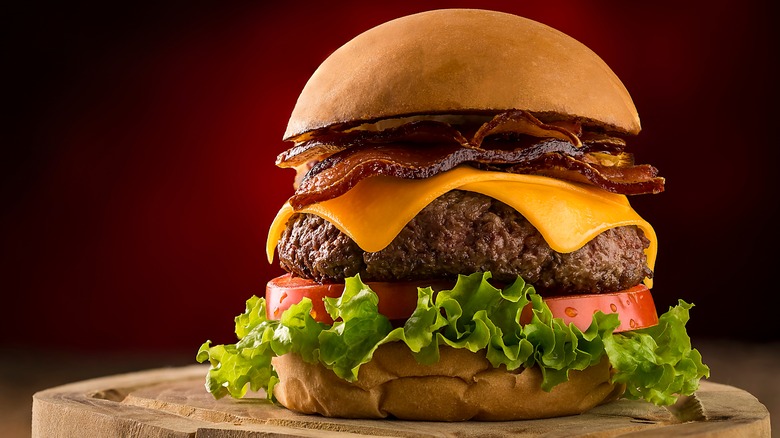16 Food Court Items You Should Avoid At All Costs
We've all been there, in the midst of a bustling food court, surrounded by the sizzling grills, the clatter of trays and cutlery, the vibrant multilingual chatter, and that mouthwatering aroma that irresistibly draws you in. Food courts, with their diverse range of international cuisine and quick-service efficiency, provide a convenient and modern dining experience that caters to our diverse tastes and busy lifestyles.
While food court restaurants' offerings can indeed be enjoyable for the taste buds, it is essential to recognize that certain choices may have repercussions beyond the immediate satisfaction. Indeed, a number of popular food court items can significantly impact your overall health and well-being. These impacts may manifest as an increased risk for heart disease, diabetes, obesity, and other health complications, driven by high levels of fat, sugar, sodium, and caloric intake. Recognizing the potential pitfalls in your food court meal is the first step towards making informed decisions that benefit your health.
1. French fries
When it comes to the universal appeal of food court items, few can compete with the omnipresent french fries. They have been a staple of quick meals worldwide, with their inviting aroma and satisfying crunch making them an irresistible choice for many. However, behind their appealing exterior lurk some less appetizing truths.
First off, french fries are fried in oils that are rich in unhealthy trans and saturated fats. These types of fats can increase your cholesterol levels, which can potentially lead to heart disease according to WebMD. While some food courts might promote the use of "healthier" oils, it's essential to remember that the frying process itself can alter the properties of the oil, leading to the formation of harmful compounds.
Portion size is another issue. A small serving can quickly become a large one, and with that, the calorie count can slowly pile up and skyrocket. The fries themselves offer very little satiety, making it easier to consume them in large amounts without feeling full. This factor, combined with their high caloric density, can contribute to unwanted weight gain.
2. Pizza
Often perceived as a complete meal — with grains from the crust, protein from the cheese and meats, and vegetables from the toppings — pizza seems like a one-stop solution for your hunger pangs. However, a closer inspection of its nutritional profile reveals a different story that goes beyond the calories in a slice of pizza.
The crust of the pizza, often made from white, refined flour, is high in simple carbohydrates. Per MedlinePlus, simple carbs have been stripped of their fiber and nutrients, causing a quick rise and fall in blood sugar levels. This can lead to hunger pangs shortly after eating, which can trigger overeating and contribute to weight gain.
Layered atop this carb-laden foundation are often generous amounts of cheese and processed meats — a combination that significantly ramps up the fat content. While cheese does provide beneficial nutrients like calcium and protein, it's also high in saturated fats and sodium, as explained by Harvard T. H. Chan School of Public Health. Similarly, processed meats such as pepperoni, sausage, or bacon can be high in unhealthy fats and are typically loaded with sodium.
3. Chicken tenders
Chicken tenders, with their golden, crispy coating and succulent meat, are a firm favorite at food courts across the nation. They are typically deep-fried, a process that significantly increases their fat and calories. Even if you're opting for white meat — generally a lean source of protein — the deep-frying process submerges the tenders in hot oil, causing them to absorb large amounts of fat. The resultant dish, while undoubtedly tasty, can contribute to an unhealthy diet if consumed regularly.
Adding to the nutritional complexity are the accompanying sauces. Staples like ranch or barbecue, while providing an added flavor punch, can also deliver a considerable caloric wallop. They often contain high levels of sugar, which can counteract the benefits of choosing lean meat like chicken. A small pack of barbecue sauce contains 9 grams of sugar, accounting for 18% of the recommended daily intake value.
4. Hot dogs
Loved by both the young and the young-at-heart, hot dogs have long been a staple of American food courts. Their simple composition — a sausage in a long bun, often topped with ketchup, mustard, and relish – belies a more complex nutritional drawback. The central issue with hot dogs resides in the sausage itself, which is a form of processed meat. A 2012 study in Current Atherosclerosis Reports shows that consumption of processed meats is associated with an increased risk of coronary heart disease and type 2 diabetes. This correlation is often attributed to high levels of sodium and preservatives like nitrates, which can negatively impact cardiovascular health.
The hot dog buns, typically made from refined white flour, lack the fiber, vitamins, and minerals that are found in whole grain alternatives, and thus provide little nutritional value. Also accompanying the hot dog sausage are the toppings, which often include ketchup and relish. While they add a burst of flavor, they also contribute a substantial amount of sugar to your meal.
5. Smoothies
Smoothies, with their vibrant colors and composition of fruit-filled goodness, have gained a reputation for being a healthy choice. However, that reputation can be, at times, undeserved. Despite their fruit content, your healthy smoothie often lacks the fiber found in whole fruits and vegetables. The blending process breaks down the fiber, reducing its presence in the final product.
Additionally, many smoothies are packed with added sugars from sweeteners, ice cream, or sweetened yogurt. These additions can transform a seemingly healthy drink into a calorie-heavy and sugar-loaded treat, negating the health benefits you would typically get from eating a whole fruit. Fiber plays an important role in slowing down sugar absorption in your bloodstream, according to Harvard T.H. Chan School of Public Heath. Without sufficient fiber and with the added sugar, the balance can tilt, turning your health drink into a sugar bomb.
In food courts, they're often served bigger, pushing the boundaries of what can be considered a single serving. This means not only are you consuming more sugar, but also more calories than you bargained for. It's important to be mindful of portion sizes; consider sharing or opting for smaller servings.
6. Burrito
The burrito: A comforting, handheld meal that seems to have all the food groups bundled up into one convenient package. But before you take that next big bite, let's unwrap some of the facts surrounding this popular food court staple.
Traditional burritos are typically wrapped in flour tortillas made from refined flour. This refined flour is quickly broken down into sugar in the body, leading to a rapid rise in blood glucose levels. As a result, you may experience a short-lived burst of energy followed by a subsequent drop, leaving you feeling hungry sooner.
While the ingredients tucked inside a burrito can be quite diverse, some common ones like cheese, sour cream, and guacamole can pack a caloric punch. It's important to note that not all of these ingredients are unhealthy — avocados, for instance, provide healthy fats, per Harvard T. H. Chan School of Public Health. However, in large quantities, they can significantly increase the total calorie count of your meal. Additionally, some typical burrito fillings like rice, meat, and beans can be high in sodium. While our bodies need some sodium to function properly, excessive intake can lead to high blood pressure, contributing to an increased risk of heart disease and stroke.
Food court burritos often come in larger sizes, resembling mini footballs rather than the traditional, modestly-sized versions. This larger size can easily lead to overeating, turning what should have been a single meal into the caloric equivalent of two or even three.
7. Nachos
Nachos, with their irresistible combination of crispy tortilla chips, gooey cheese, and unlimited possibilities of toppings, have become a popular indulgence in food courts. Most nachos are made with fried corn tortilla chips, which can be high in unhealthy fats and calories. The deep-frying process not only adds extra fat but also increases the caloric content.
The melted cheese served with nachos adds richness and creaminess, but it can also contribute to a high calorie and saturated fat content, as explained by the British Heart Foundation. Too much cheese can quickly add up in terms of calories. Toppings like sour cream, guacamole, and salsa can enhance the flavor of nachos but should be used in moderation. Sour cream and guacamole are high in calories and fat, while salsa can be high in sodium.
Size does matter, especially when it comes to nachos. Food court portion sizes tend to be on the generous side. What is marketed as a snack or appetizer can easily equate to a full meal's worth of calories, leading to unintended overconsumption.
8. Sushi rolls
Sushi rolls, with their pleasing aesthetics and flavorful combinations, are a frequent choice for those looking for something lighter at the food court. But beware, not all sushi rolls are created equal. While fresh fish, vegetables, and seaweed provide essential nutrients, some rolls may include ingredients that can impact the overall nutritional profile. Rolls with tempura, cream cheese, or mayo-based sauces can be high in fat and calories. Tempura, in case you're not familiar, is a method of deep frying — and anything deep fried carries a higher fat and calorie load. Similarly, cream cheese and mayo-based sauces, while delicious, also contribute significantly to the calorie and fat content of the roll.
Most sushi rolls are made with white rice, which is high in simple carbohydrates and can lead to a quick rise in blood sugar levels, according to this Harvard study. Western-style sushi rolls are often larger than their traditional Japanese counterparts. These bigger bites can lead to carb overload, as it's easy to underestimate just how much you're consuming in one sitting. To top it off, the soy sauce served with sushi rolls is high in sodium.
9. Chicken wings
Chicken wings, with their crispy skin and succulent meat, are a beloved choice in food courts across the nation. Often deep-fried and served with a variety of dipping sauces, they have become a go-to comfort food for many. Deep frying gives chicken wings their irresistible crunch but it also contributes to a high fat content. The frying process can cause the wings to absorb unhealthy fats, which can contribute to weight gain when consumed in excess.
Many wing sauces are made with ingredients that can significantly increase the calorie count. Per WebMD, creamy dressings like ranch and blue cheese are typically high in calories due to their creamy base and added fats. Traditional buffalo wings use sauce that contains a combination of butter and hot sauce, which can contribute to a higher calorie content. BBQ sauce contains added sugars to achieve that sweet and tangy flavor profile. Those sauces also contain significant amounts of sodium primarily from salt to balance out all the flavors.
10. Fried rice
Fried rice is typically made by stir-frying cooked rice with a variety of ingredients like vegetables, meats, and sauces. While the ingredients themselves can be nutritious, it's important to note that the cooking method often involves the use of oil, which contributes to the higher fat content of the dish. The type and amount of oil used can greatly impact the overall nutritional profile of the fried rice.
WebMD explains that soy sauce and other condiments commonly used in fried rice can be high in sodium, which can contribute to elevated blood pressure and an increased risk of heart disease. Being mindful of portion sizes and opting for reduced-sodium soy sauce can help manage sodium intake.
Food court fried rice is typically made with white rice. The high glycemic index (GI) of white rice is another nutritional aspect to consider. The GI measures how quickly a food raises blood sugar levels, according to MedlinePlus. Due to its refined nature, white rice is quickly digested and absorbed, leading to a rapid increase in blood sugar levels. This can result in a sudden spike in energy followed by a subsequent drop, potentially leaving you feeling hungry sooner.
11. Bacon, egg, and cheese sandwiches
Bacon, often beloved for its smoky and crispy flavor, is high in saturated fat, cholesterol, and sodium. Excessive consumption of saturated fat can contribute to an increased risk of heart disease and other health issues. While eggs are a good source of protein, it's important to note that the yolk contains dietary cholesterol. Per a 2016 study in the Journal of Translational Internal Medicine, "One large (65g) egg yolk contains 237 mg of cholesterol, well above the recommended limit."
Processed cheese slices, commonly found in food court bacon, egg, and cheese sandwiches, can be high in calories, saturated fat, and sodium. These attributes can contribute to weight gain, elevated cholesterol levels, and increased blood pressure.
Food court bacon, egg, and cheese sandwiches are typically made with refined flour bread, which lacks the fiber and nutritional benefits of whole grains. According to Healthline, this refined bread can lead to a rapid rise in blood sugar levels due to its high carbohydrate count as well as trigger insulin spikes, and potentially leave you feeling hungry sooner and impacting your energy levels throughout the day.
12. Fish and chips
Fish and chips, a classic dish often found in food courts, combines crispy battered fish with french fries, all accompanied by a tartar sauce. Let's address the most obvious aspect of this popular dish: It's deep-fried. When fish and potatoes are deep-fried, they absorb some of the oil, resulting in a higher fat content. This can contribute to a higher calorie intake and an increased risk of weight gain and chronic health conditions when consumed in excess.
Deep-frying also affects the nutritional quality of the ingredients. While fish is a good source of lean protein and essential omega-3 fatty acids, a review in the MPDI journal Processes tells us that deep frying reduces the overall nutritional value by increasing fat and reducing the omega-3 fatty acid levels. Similarly, potatoes, which are naturally rich in nutrients like potassium and vitamin C, lose some of their nutritional benefits when deep-fried.
Tartar sauce, typically served with fish and chips, is high in calories, fat, and sodium. The overall combination of the deep-fried fish and potatoes with the rich tartar sauce creates a meal that is high in both fat and sodium. As a reference, a serving of Hand-Battered Fish & Chips on the Applebee's menu served with fries and tartar sauce contains 1,470 calories with 95 grams of fat, 21 grams of saturated fat, 150 milligrams of cholesterol, and 3,200 milligrams of sodium.
13. Ice cream sundaes
You guessed it correctly. The primary concern with ice cream sundaes is their high sugar content. Ice cream itself is loaded with sugar, and when combined with sugary sauces, syrups, and toppings, the sugar content can skyrocket. Excessive sugar consumption can lead to a multitude of health issues, including weight gain, tooth decay, and an increased risk of chronic conditions such as diabetes and heart disease as explained by the CDC.
Aside from the high sugar content, ice cream sundaes can also be high in unhealthy fats. Full-fat ice cream and toppings like whipped cream or chocolate candies contribute to the overall fat content of the dessert. Consuming too much saturated and trans fats can negatively impact heart health and increase cholesterol levels. Food court sundaes are often served in large sizes, which can lead to overconsumption of calories, sugar, and fats.
But we all love ice cream sundaes, right? So instead of completely avoiding it, we can make smarter choices and enjoy it in moderation. Whenever available, opting for light or sugar-free ice cream can be a great way to limit sugar intake. And instead of indulging in a large ice cream sundae, consider having a smaller serving or sharing with a friend.
14. Doughnuts
Whether it's the sweet glazes, sugary fillings, or powdered sugar coatings, doughnuts are the hottest party food. We understand by now that excessive amounts of sugar can cause weight gain and negatively impact our health. On top of that, doughnuts are typically made with refined flour that can cause a rapid spike in blood sugar levels leading to a quick energy boost followed by a subsequent crash, leaving you feeling tired and hungry shortly after consumption. Cooking doughnuts involve deep frying that boosts fat content, including unhealthy trans fats, which can increase the risk of heart disease when consumed in excess.
While doughnuts may not be the healthiest choice, it's important to approach them as an occasional cheat snack. Moderation is key, and enjoying a doughnut as a special treat every now and then can be part of a balanced lifestyle. Pairing a doughnut with a source of protein or fiber, such as a side of Greek yogurt or a piece of fruit, can help slow down the absorption of sugar and provide a more balanced snack.
15. Gyros
This savory blend of seasoned meat served with tangy sauce and warm pita bread or rice has gained popularity as a go-to Mediterranean option in food courts. Gyros typically feature processed meats that are high in sodium and fat.
Traditionally, they are served with white pita bread and other carbs like seasoned rice or french fries, which provide little in terms of fiber or nutrients. The high carbohydrate content of both can lead to a quick rise in blood sugar levels, potentially leaving you feeling hungry sooner and impacting your energy levels. Additionally, the generous portion sizes often served in food courts can contribute to overconsumption.
Gyros is usually accompanied by tzatziki sauce, a creamy and tangy sauce made from yogurt, cucumber, garlic, and herbs. Tzatziki sauce typically contains yogurt, which can be a good source of protein and probiotics. However, some food court versions of tzatziki may have higher fat content due to the use of full-fat yogurt or added oils. Also, the sauce may have added ingredients like mayonnaise or sour cream, which can increase the overall calorie and fat intake.
16. Hamburger
From the sizzling patty to the array of toppings and condiments, hamburger is the epitome of American fast food and a beloved staple in food courts across the nation. You can't go wrong with a burger but without proper caution, things can really go wrong. While burgers may seem like a straightforward convenience, there are a few factors to consider for a well-rounded perspective.
One concern is the high sodium content often found in fast food burgers. Processed meats, condiments, and pickles can all contribute to an elevated sodium intake. Excessive sodium consumption can lead to increased blood pressure, fluid retention, and potential negative effects on heart health.
Another consideration is the presence of unhealthy fats, particularly saturated and trans fats, in fast food burgers. These fats can contribute to higher levels of LDL cholesterol, also known as "bad" cholesterol, and increase the risk of heart disease when consumed in excess per the CDC. Additionally, the cooking methods used for fast food burgers, such as grilling or frying, can further elevate the fat content.
Fast food burgers are often accompanied by a side of french fries and sugary beverages, which can significantly contribute to the overall calorie and sugar intake of the meal. Consuming these calorie-dense sides regularly can lead to weight gain and an increased risk of developing chronic conditions such as obesity and type 2 diabetes.
















